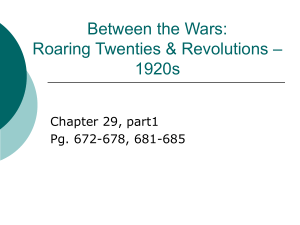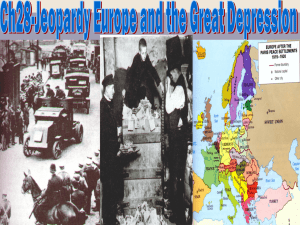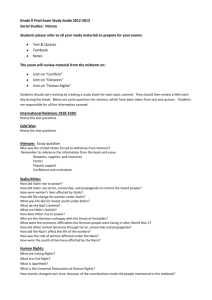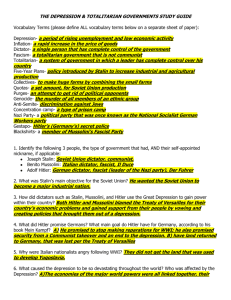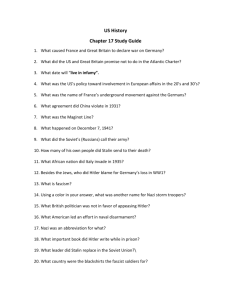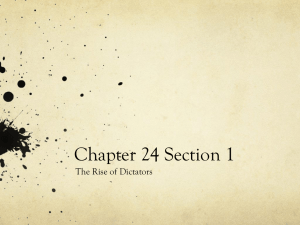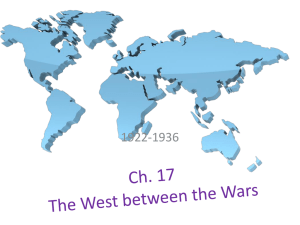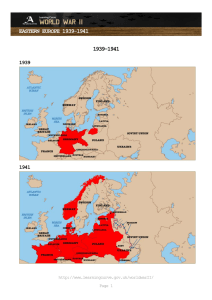26 Summary - Avon Grove School District
advertisement
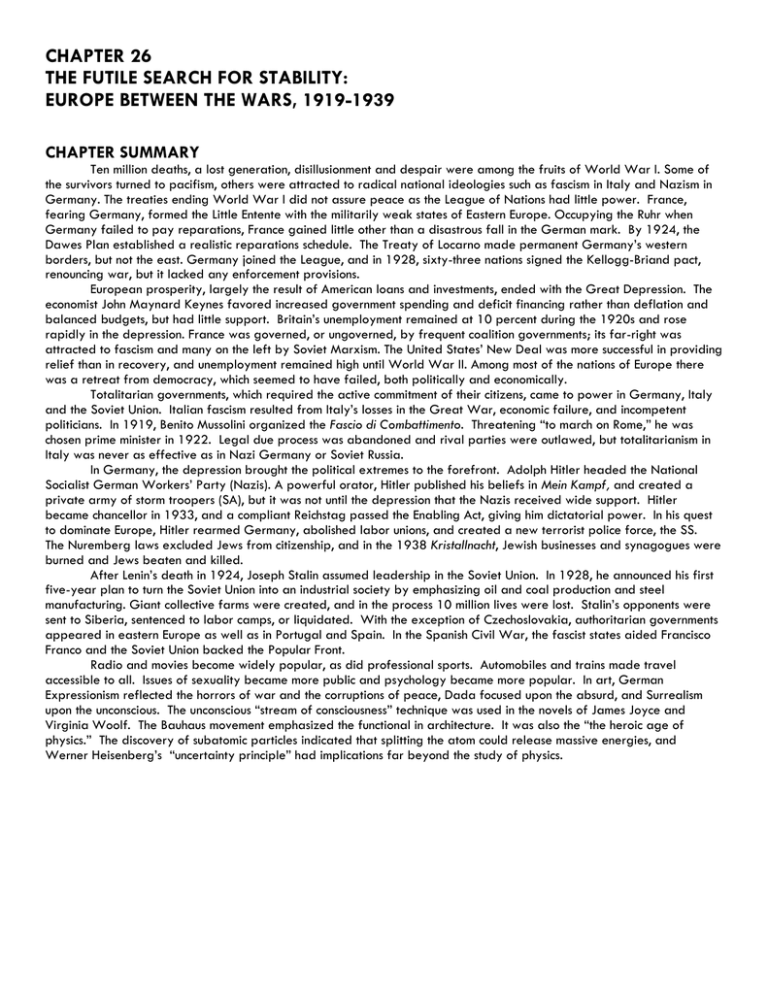
CHAPTER 26 THE FUTILE SEARCH FOR STABILITY: EUROPE BETWEEN THE WARS, 1919-1939 CHAPTER SUMMARY Ten million deaths, a lost generation, disillusionment and despair were among the fruits of World War I. Some of the survivors turned to pacifism, others were attracted to radical national ideologies such as fascism in Italy and Nazism in Germany. The treaties ending World War I did not assure peace as the League of Nations had little power. France, fearing Germany, formed the Little Entente with the militarily weak states of Eastern Europe. Occupying the Ruhr when Germany failed to pay reparations, France gained little other than a disastrous fall in the German mark. By 1924, the Dawes Plan established a realistic reparations schedule. The Treaty of Locarno made permanent Germany’s western borders, but not the east. Germany joined the League, and in 1928, sixty-three nations signed the Kellogg-Briand pact, renouncing war, but it lacked any enforcement provisions. European prosperity, largely the result of American loans and investments, ended with the Great Depression. The economist John Maynard Keynes favored increased government spending and deficit financing rather than deflation and balanced budgets, but had little support. Britain’s unemployment remained at 10 percent during the 1920s and rose rapidly in the depression. France was governed, or ungoverned, by frequent coalition governments; its far-right was attracted to fascism and many on the left by Soviet Marxism. The United States’ New Deal was more successful in providing relief than in recovery, and unemployment remained high until World War II. Among most of the nations of Europe there was a retreat from democracy, which seemed to have failed, both politically and economically. Totalitarian governments, which required the active commitment of their citizens, came to power in Germany, Italy and the Soviet Union. Italian fascism resulted from Italy’s losses in the Great War, economic failure, and incompetent politicians. In 1919, Benito Mussolini organized the Fascio di Combattimento. Threatening “to march on Rome,” he was chosen prime minister in 1922. Legal due process was abandoned and rival parties were outlawed, but totalitarianism in Italy was never as effective as in Nazi Germany or Soviet Russia. In Germany, the depression brought the political extremes to the forefront. Adolph Hitler headed the National Socialist German Workers’ Party (Nazis). A powerful orator, Hitler published his beliefs in Mein Kampf, and created a private army of storm troopers (SA), but it was not until the depression that the Nazis received wide support. Hitler became chancellor in 1933, and a compliant Reichstag passed the Enabling Act, giving him dictatorial power. In his quest to dominate Europe, Hitler rearmed Germany, abolished labor unions, and created a new terrorist police force, the SS. The Nuremberg laws excluded Jews from citizenship, and in the 1938 Kristallnacht, Jewish businesses and synagogues were burned and Jews beaten and killed. After Lenin’s death in 1924, Joseph Stalin assumed leadership in the Soviet Union. In 1928, he announced his first five-year plan to turn the Soviet Union into an industrial society by emphasizing oil and coal production and steel manufacturing. Giant collective farms were created, and in the process 10 million lives were lost. Stalin’s opponents were sent to Siberia, sentenced to labor camps, or liquidated. With the exception of Czechoslovakia, authoritarian governments appeared in eastern Europe as well as in Portugal and Spain. In the Spanish Civil War, the fascist states aided Francisco Franco and the Soviet Union backed the Popular Front. Radio and movies become widely popular, as did professional sports. Automobiles and trains made travel accessible to all. Issues of sexuality became more public and psychology became more popular. In art, German Expressionism reflected the horrors of war and the corruptions of peace, Dada focused upon the absurd, and Surrealism upon the unconscious. The unconscious “stream of consciousness” technique was used in the novels of James Joyce and Virginia Woolf. The Bauhaus movement emphasized the functional in architecture. It was also the “the heroic age of physics.” The discovery of subatomic particles indicated that splitting the atom could release massive energies, and Werner Heisenberg’s “uncertainty principle” had implications far beyond the study of physics. 1. the Unknown Soldier(s) 2. League of Nations 3. Little Entente 4. Dawes Plan 5. Treaty of Locarno 6. Kellogg-Briand pact 7. Great Depression 8. John Maynard Keynes 9. the Popular Front 10. the New Deal 11. Ataturk and Mohandas Gandhi 12. totalitarianism 13. Benito Mussolini 14. Fascio di Combattimento 15. squadristi 16. the blackshirts 17. “Women into the home” 18. Weimar Republic 19. Adolph Hitler 20. Mein Kampf 21. Nazis 22. Lebensraum 23. Fuhrerprinzip 24. the Enabling Act 25. “Germany Awake” 26. Aryanism 27. Hitler Jugend 28. Nuremberg laws 29. Kristallnacht 30. “war communism” 31. New Economic Policy 32. Joseph Stalin 33. five-year plans 34. Stakhanov cult 35. collective farms 36. Francisco Franco and the Spanish Civil War 37. “wireless” and the BBC 38. Birth of a Nation and The Blue Angel 39. Dopolavoro and Kraft durch Freude 40. Oswald Spengler’s The Decline of the West 41. Marie Stopes’ Married Love 42. German Expressionism 43. George Grosz and Otto Dix 44. Dadaism 45. Hannah Hoch and Tristan Tzara 46. Surrealism 47. Salvador Dali’s The Persistence of Memory 48. Louis H. Sullivan and the Chicago School 49. Frank Lloyd Wright 50. Bauhaus School and Walter Gropius 51. Kurt Weill’s The Threepenny Opera 52. “degenerate art” 53. “socialist realism” 54. Arnold Schoenberg and atonal music 55. “stream of consciousness” 56. James Joyce’s Ulysses and Virginia Woolf’s Mrs. Dalloway 57. Hermann Hesse’s Steppenwolf 58. Carl Jung 59. Ernest Rutherford and the atom 60. Werner Heisenberg and the uncertainty principle
